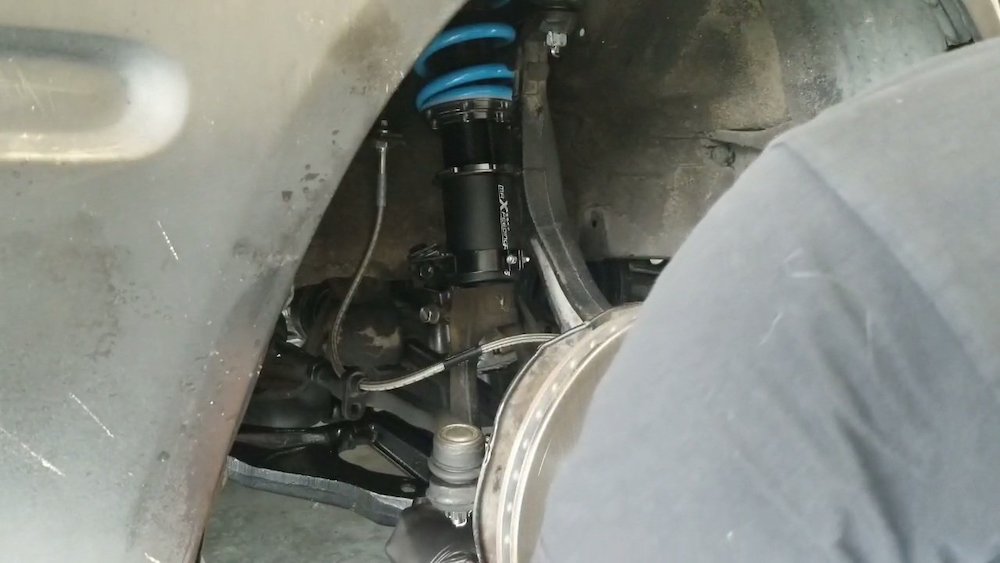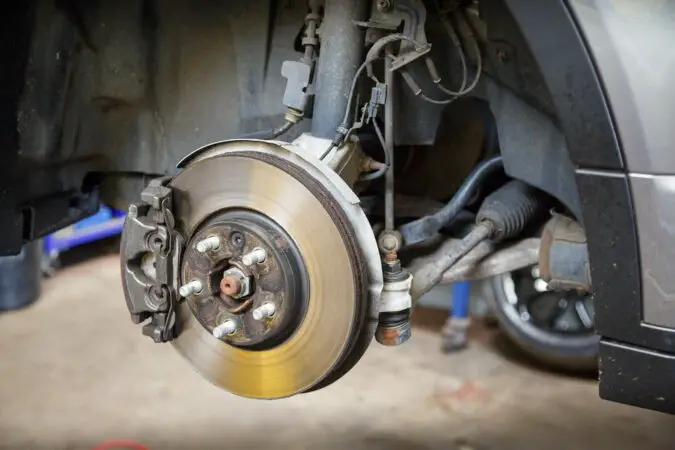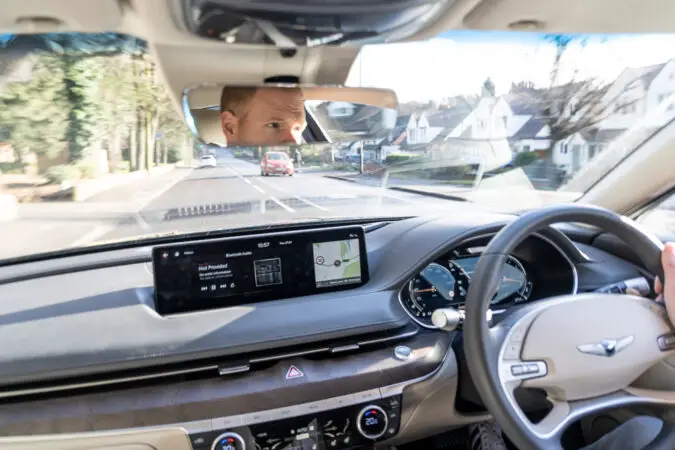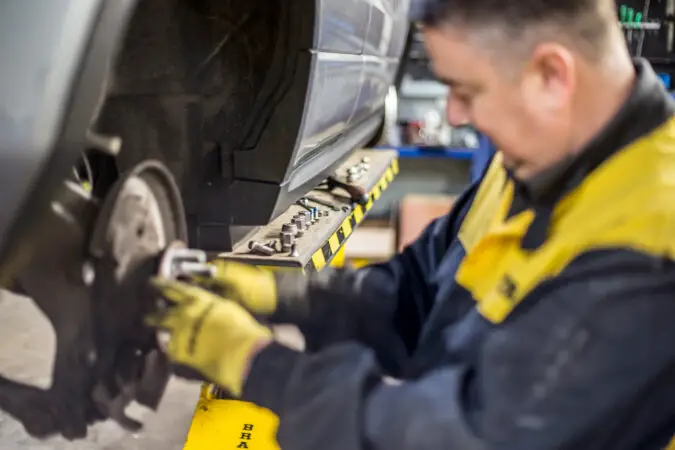Are you feeling that your front suspension is out of alignment? If this is the case, then you might be suffering from bad tie rod end links. But you shouldn’t worry because we are going to help you out with your problem.
Having a suspension problem could be tricky to tackle. I’m saying this because there are a ton of components in the modern front suspension and it could just be a bit overwhelming for beginners to get a grasp on all of these components and learn what is their task and what they are doing in general.
So, when it comes to diagnosing a problem like this, it could be difficult. That’s why you first need to familiarize yourself visually. Mostly by watching videos and checking a lot of images and diagrams of how everything is connected together.
In addition to this, you need to familiarize yourself with what symptoms a certain component produces. This is a real lifesaver that will save you a ton of money since you will be able to diagnose problems on your own without dealing with greedy mechanics that often want to rip you off for a small job like replacing a tie rod end link. But we are going to help you out with that.
First, we are going to learn what are tie rod end links and why they are so important. Then we will discuss where they are located and the symptoms of the bad tie rod end. We will also learn how to diagnose the matter and how to replace them. So if you want to learn more follow along.
What Is A Tie Rod End?
So, what is a tie rod end in general? Many people are not even knowing what this component is so it is useful to elaborate a little bit on the basics of this component and learn more about what it is and what is its role. If you feel that you are knowledgeable and you know about this component, you can move on to the symptoms of a bad tie rod end. If else, keep up with us.
So, what is a tie rod end? A tie rod end in simple words is a connector. It connects the tie rod with the steering rack on one side and the knuckle on the other side. Meaning that there are two tie rod ends on each of the front wheels.
These tie rod ends are called inner tie rod ends and outer tie rod ends. The inner tie rod ends are connected to the steering rack while the outer tie rod ends are connected with the steering knuckle.
It doesn’t matter how old is the vehicle, it must have a tie rod end link. These are some of the suspension components that haven’t changed a lot throughout the years. When you learn what is a tie rod end, you simply know what this component is and where it is located. But more on the location, we are going to elaborate in the following chapters.
As we mentioned above, there are inner and outer tie rods. Both of these are implementing a ball joint design and both of them need to be properly greased and lubricated for friction to be avoided. But what is their function? We will elaborate on why the tie rod end is important in the following chapter.
Why The Tie Rod End Is Important, And Where It Is Located?
Now let’s discuss why the tie rod end link is important and what is the function of this component? It must have a role that it needs to play to be installed on every motor vehicle in history, right?
That’s right. This component has an extremely useful role and it serves as a connector. One end of the tie rod as we mentioned is connected to the steering rack and the other to the knuckle.
So, it means that is located right behind the caliper. If you turn the steering wheel fully to the left or right, you will be able to detect the ball joint of the tie rod end covered with a rubber boot. You will notice how it is connected to the knuckle.
These end links connect the steering rack with the front wheels. Meaning that they make sure that you feel well connected with the road and that your steering doesn’t feel loose.
But the most important role these components have is that they direct the wheel when and how much to turn. They are transferring the input from the steering rack to the wheels.
So, considering this, you can imagine how important they are in terms of steering quality and the overall drivability of the vehicle. Without them being in check, the alignment will be out of balance and a lot of symptoms will be noticed and you don’t want this to happen. In the following chapters, we are going to elaborate on these symptoms of a bad tie rod end.
Symptoms Of Bad Tie Rod End
Now let’s discuss the symptoms of bad tie rod end links. It is important to note that there are a ton of these symptoms when these tie rod ends decide to give up on you.
That’s why it is often advised to learn them all if you want to diagnose the problem. In the following chapters, we are going to cover all of them in detail and learn what you can expect when these tie rod end links fail, and after, we will discuss more on diagnosing and sorting this problem out permanently. So, if you want to learn more, follow along.
1. Strange Sounds Coming From The Front End
When the tie rod end is bad, you will notice some weird sounds coming from the front end. In most cases, these sounds come when the car is in motion. Meaning that often happens when you drive the car.
Most notable are the squeaking sounds that develop. These sounds often happen when you go over bumps. These sounds happen because there is no lubrication in the ball joint. The metal is rubbing against metal and these squeaking noises or clunking noises happen.
In addition to this, there are squealing noises that happen as well. Like in the old Hollywood movies when the car is turning at high speed and that squealing sound occurs.
And when the ball joints have failed, this sound is much more pronounced and even at a low-speed corner, the wheels will squeal and develop these noises. So, when you hear something happening in the front end. It is important for you to check it out and replace the tie rod end if needed. More on diagnosing and replacing we are going to discuss later in the article, Now, let’s move on to the following symptom.
2. Steering Wheel Is Not Straight
Another symptom of a bad tie rod end besides the sounds is the steering wheel not straight problem that often happens on vehicles that have bad alignment.
This bad alignment is often caused by bad tie rod ends and it could greatly impair your driving ability.
A car like this with this problem could also be dangerous to drive because it could be a bit unpredictable. The steering wheel could be positioned straight in dead center. But the car would love to go on the left or the right depending much on where this problem occurs.
So, driving like this is not recommended. You will need to understand the car and know where is the dead center to drive it as it should. If not, you could end up in a ditch on the side of the road. This is a symptom of a bad tie rod end and bad alignment that cannot be ignored and needs to be sorted out as soon as possible. Now move on to the following symptom.
3. The Steering Wheel Is Loose
Another symptom of a bad tie rod end is the situation when the steering wheel is loose. This is a symptom that probably nobody wants but it knows to happen.
It usually happens on older cars but it knows to happen in more modern vehicles as well. What is a characteristic of this symptom is the steering wheel that has a lot of play in it. You move the steering wheel left or right but you don’t see any movement of the wheels. The car keeps driving straight.
This is not an ideal situation because you need sharp steering if you want to be safe on the road. This is often the case because the ball joints are really worn out and they simply have a lot of play in them. The tie rod moves instead of being fixed and properly secured.
The only way to solve this problem is to replace the end links with new ones and the problem would probably get sorted. If not, you need to check the rack itself and see if it’s faulty. Which can be rather expensive to fix and replace. So, cross your fingers that it’s up to the tie rod end. Now let’s move to the next symptom.
4. Vibrations From The Steering Wheel
Another symptom of a bad tie rod end is the symptom when the driver feels vibrations on the steering wheel.
If the steering wheel vibrates, it means something is not right, either with the steering rack and pinion or the tie rod and ball joints.
When this happens it is important to inspect the matter because the problems could be serious. Most often the steering rack leaks and there is a lot of friction causing these vibrations. Sometimes the ball joints are causing these vibrations if they are too worn out. Or the car was in an accident and the rod ends are not straight.
Either way, this problem requires proper diagnosing and making sure what is causing the issue. Then the faulty components need to be properly replaced with new ones to get things sorted out the right way. But the most probable reason for this problem is a faulty inner tie rod end link. And luckily, this is the cheapest thing that could go wrong. Later we are going to discuss how this problem is sorted out in the right manner. Now let’s discuss the rest of the symptoms.
5. Car Is Pulling On One Side
Another common symptom with a bad tie rod end is the situation when the car is pulling on one side. So, how does this happen?
Well, imagine that you drive on the highway and the car simply turns left or right depending much on the problem itself. This is not good and you probably put your life in danger.
In this case, the only thing you can do is to constantly correct the steering wheel and adjust it so you don’t crash. Driving like this is not recommended and it is dangerous.
Also, you will be highly likely to fail an inspection because of this problem. Your best bet when it comes to this problem is to learn how to diagnose it and then replace the tie rod end with the ball joint and cross your fingers that this will hopefully solve your problem. Because the steering rack can also cause this issue and repairing it could cost a fortune. Now, let’s move to the last symptom of a bad tie rod end.
6. Uneven Tread Wear
Another important symptom that often indicates bad tie rod end is uneven tread wear. As you know, your front and rear tires should wear equally. If they do not wear equally, it might indicate that you have a problem with your car.
So, how this is checked? The first thing you need to do is to park your vehicle and inspect the tires visually. Nothing too complicated.
If the tires are worn on the inside or on the outside instead of being worn evenly. It means that you have a problem that you need to sort out. This is simply bad alignment. But this bad alignment could be caused by worn suspension components.
And you don’t just jump and replace the tires. Because if you only replace your tires, the problem will continue. The problems with the suspension have to be sorted first and then you can move on to the tires. Everything has to be sorted out if you want to return your front suspension to OEM spec and the car to get its driving capability back to normal.
By this we mean replacing the tie rod end and ball joints, replacing some bushings, struts if they are worn. And then move to the tires if you want to sort this problem permanently. We are basically done with the symptoms, now let’s move on to the process of diagnosing a bad tie rod end.
How To Diagnose A Bad Tie Rod End?
Now let’s learn how to diagnose a bad tie rod end. What is the method of learning the condition of the tie rods and deeming them for replacement?
Well, it’s actually quite simple to diagnose them. But let’s elaborate on the process in detail and learn how it is done in practice.
The first thing you need to do is to jack the car in the air. Make sure that the wheel you want to inspect is floating.
Then grab the wheel from both sides and shake it left and right. If the wheel moves and has a ton of play. Then the tie rods are done and need replacing.
Also, turn the steering wheel on the inside and check the condition of the ball joints. If they have leaked and are all cracked boots then you definitely need to replace the outer tie rod end.
The next thing would be to check the inner tie rod end. And you can do this by turning on your flashlight and seeing if there are leaks on the steering rack boot. To check the inner tie rod, you need to apply some weight to it and see if there is play in it. If there is, then you probably need to replace this tie rod.
Not to mention that there are the symptoms that we covered above, the vibrations in the steering wheel, the steering wheel pulling on one side, the problems with the tire wear. All this is meaning that there are some problems either with the inner or with the outer tie rod end.
On more how to diagnose this problem. You can check out the video that we attached where the man is explaining the methods of diagnosing a bad tie rod end.
How To Replace Tie Rod Ends?
Replacing the tie rod end is not that difficult. What is essential for you to have the tooling. Removing these tie rods requires special tools that you need to do this operation successfully on your vehicle.
You can rent these tools from your local Autozone or Oreilly’s for a few bucks and do this job. Renting them is a smart move because why would you need them later, you don’t replace tie rods every day to be a need for these tools. But if you want to go overboard, you can just buy them. They are not expensive after all.
Explaining how this is done can be a bit tricky. So, we are going to attach a video for you to see and learn how this procedure is done the right way.
The important thing is not to hurry and damage something in the process. Take your time and investigate how these jobs are pulled off the right way and then perform the job. Over the weekend would be a great time to do it since you are probably free from your obligations and you can focus on the tie rods and their replacement. But what is the cost to replace a tie rod end? Well, that’s what we are going to cover next.
Cost To Replace A Bad Tie Rod End
So, what is the cost to replace a tie rod end? Well, the cost greatly depends on whether you want to replace the inner and the outer tie rods or both.
A single tie rod on average is about $50 so, $100 would be the total for one side for the parts alone. Not that expensive after all. You can rent tools on the cheap from your local car hardware store. And overall, you will not pay more than $150 per side.
But if you do this work at a shop, you will pay more money. The labor is quite expensive and you could end up paying about $150 to $200 for this job only for the labor. With the parts, the price will be about $250 to $300.
As you can see, this is really not an expensive repair and it could be done at home with decent mechanical knowledge in a few hours or so. So, if you want to wrench, replacing a tie rod end would be a nice way to start your wrenching endeavors. But do you need an alignment with this? That’s what we are going to learn next.
Do I Need An Alignment?
The short answer is yes, you need an alignment whenever you replace a tie rod end. This is the case because whenever you make changes to your suspension, the car would be out of alignment.
If you don’t perform an alignment, you can expect problems to appear on your car. These can be quite similar to the symptoms that we covered in this article. Most notable problems could be uneven thread wear, steering wheel not being centered, or pulling on one side. You can expect these issues when the car is not properly aligned.
Tie Rods: Facts You Need to Know
- Tie rods are a crucial part of a vehicle’s steering system, connecting the steering rack to the steering knuckle.
- Without tie rods, steering a vehicle would be impossible, as they help move the wheels when steering and make turning possible.
- Tie rods are susceptible to damage and wear due to normal use, driving hazards such as potholes, and accidents.
- A failing tie rod can cause symptoms such as uneven or excessive tire wear, a front end out of alignment, steering wheel vibration or looseness, and knocking or clunking sounds.
- Uneven tire wear can be a sign of a failing tie rod, while even wear indicates proper functioning.
- A worn tie rod can become loose, causing the front end of the vehicle to become misaligned and affecting steering.
- Steering problems can be a symptom of a loose or damaged tie rod, with common signs including a shaking or vibrating steering wheel and excessive play.
- Knocking or clunking sounds from the front of the vehicle when turning at low speeds can indicate bad tie rods, as they rattle around at the joints and links when loose.
- If a tie rod becomes damaged and fails, it can compromise the safety of the driver and passengers by making it difficult to control the vehicle.
- If any symptoms of a failing tie rod are noticed, it is important to consult a qualified technician right away to ensure the safe operation of the vehicle.
Conclusion To Tie Rod End
In this article, we have covered quite a bit when it comes to the tie rod end. We learned what these components are and that there are two of them, an inner rod and an outer rod. The inner is connected to the steering rack, while the outer is connected to the knuckle via the ball joint.
Then we discussed the symptoms of a bad tie rod end. And it is worth mentioning that there are a few of them. Mainly vibrations, steering wheel not straight, uneven tread wear on the tires, and other smaller symptoms.
After we covered the diagnosing process and the replacement process of these components. Overall, not a complex job, you only need the right tooling to sort them out. And also, do not forget to do an alignment when done.




